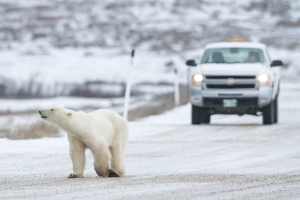“Despite our growing knowledge about polar bears,” writes Michael Engelhard in his 2017 book Ice Bear: The Cultural History of an Arctic Icon, “unscientific views of the bear as a man-eating monster persist.”
But the results of a new study that looked at every recorded instance of polar bear attacks on humans in the five places the animal lives in the wild — Canada, the United States, Greenland, Norway and Russia — over a 144-year period may go some way to correcting the myth of the rampaging white bear with a taste for human flesh.
The study, published in the June issue of the Wildlife Society Bulletin, found that there were only 73 recorded attacks between 1870 and 2014, 20 of which were fatal. An exhaustive study of the accounts of those attacks has led the researchers to suggest that “nutritionally stressed adult male polar bears were the most likely to pose threats to human safety.”
In other words, it’s likely that the bears only preyed upon people when the bears were starting to starve.
James Wilder, one of the study’s co-authors, told the CBC that polar bears usually avoid risk because they must hunt — unlike black or grizzly bears, both of which will eat plants if necessary. “If they get injured, that impairs their ability to hunt,” Wilder told the CBC. “There isn’t a lot of incentive for them to be aggressive — unless times are bad. That seems to flip a switch. They seem to turn into a different beast.”
And climate change could be helping to flip that switch, driving bears into more frequent conflict with humans as Arctic sea ice declines. “Increased concern for both human and bear safety is warranted in light of predictions of increased numbers of nutritionally stressed bears spending longer amounts of time on land near people because of the loss of their sea ice habitat,” says the study.
Wilder and his colleagues found that “the greatest number of polar bear attacks occurred in the partial decade of 2010–2014, which was characterized by historically low summer sea ice extent and long ice-free periods that have been linked to increased land use in a number of subpopulations.”
By the numbers
Here are some notable numbers drawn from the study.
38 The number of confirmed polar bear attacks that took place in Canada during the period the study analyzed (1870-2014), more than any of the other four locations where polar bears live in the wild. Russia had the second highest number of attacks (15), followed by Norway (10), the United States (six) and Greenland (four).
61 The per cent of polar bears that were in “below-average body condition” — i.e. skinny or thin — when they attacked people. An “attack” was defined as intentional contact by a bear resulting in human injury.
65 The per cent of polar bears that were in “below-average body condition” when they made a predatory attack on humans. A “predatory attack” was defined as one in which a bear preyed upon, or attempted to prey upon, people.
64 The per cent of polar bears that were in “below-average body condition” when they fatally attacked people.
59 The per cent of polar bear attacks in which a person’s behaviour contributed to the attack. Examples of such behaviours include shooting and wounding a bear or its cub, getting too close to or provoking the bear, feeding the bear, sleeping on the ice and running from the bear.
88 The per cent of polar bear attacks since 2000 that have happened between July and December, a span that includes the period of time when sea ice is at its minimum extent.





